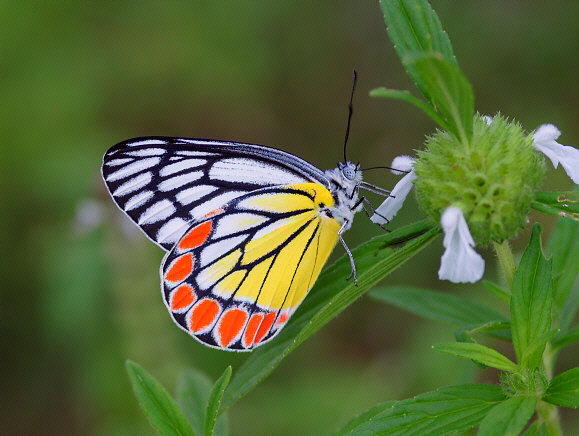
Introduction
There are about 225 described species in the genus Delias. The butterflies are popularly known as Jezebels. Most species are gaudily patterned in red, yellow, black and white – the colours serving to advertise their unpalatable nature to would-be predators.
Many of the species are highly localised, being endemic to particular islands in south-east Asia, or restricted to certain mountain ranges, e.g. in New Guinea. Others occupy much broader ecological niches, and are more generally distributed.
Among the latter group are hyparete which is distributed from India to s.w. China, the Philippines, peninsular Malaysia, Sumatra, Borneo, Java and Bali; and eucharis which is found in India, Burma and Sri Lanka.
D. eucharis and hyparete are similar in appearance, but can be told apart by the black apical band on the forewing. In hyparete the band forms an arc, and terminates at the tornus. In eucharis the lower half of the band runs parallel to the outer margin, and terminates part way along the inner margin. There are also differences in the red markings on the underside hindwings – in hyparete these fuse together to form a suffused band, but in eucharis they are separated into distinct shield-shaped red spots.
Habitats
Delias eucharis is nomadic in behavior, and can be found in a wide variety of habitats including temperate hill forest, tropical rainforest, dry open woodland and beach hinterlands. It is a common species in flowery gardens, and commonly visits flowering bushes in towns. The butterfly can be found at altitudes between sea level and at least 1500m.
Lifecycle
The larval foodplant is mistletoe – Loranthus (Loranthaceae).
Adult behaviour
The butterflies spend much of their lives high in the tree tops where their larval foodplants grow as parasites on a variety of tree species. They can often be seen flying from tree to tree on sunny mornings. Periodically however both sexes will descend and embark on a “nectaring run”, fluttering swiftly from garden to garden, pausing here and there for a moment to sip the nectar of Lantana (Verbenaceae), Mentha (Lamiaceae), and other flowers. When nectaring, the wings are usually kept fluttering to support the weight of the butterfly.

